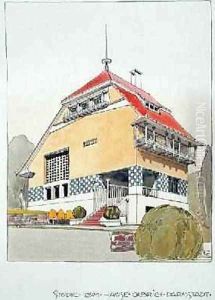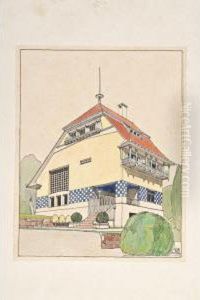Joseph Maria Olbrich Paintings
Joseph Maria Olbrich was an Austrian architect and co-founder of the Vienna Secession, a group that sought to break away from the traditional academic art and architecture of the late 19th century. Born on December 22, 1867, in Troppau, in the Austro-Hungarian Empire (now Opava, Czech Republic), Olbrich was a key figure in the development of the Art Nouveau movement in Central Europe.
Olbrich studied architecture at the Vienna University of Technology and later under the influential architect Otto Wagner, who was a proponent of modern design principles. Wagner's emphasis on function and a simplified form had a significant impact on Olbrich's approach to architecture and design.
In 1897, along with Gustav Klimt, Koloman Moser, and others, Olbrich co-founded the Vienna Secession. This was a pivotal moment in his career, as the group advocated for a new, modern style that was free from the constraints of historical influence. As a member of the Secession, Olbrich designed the group's exhibition building, the Secession Building in Vienna, which was completed in 1898. This structure, with its iconic dome of golden laurel leaves, became a symbol of the movement and is considered one of Olbrich's masterpieces.
Throughout his career, Olbrich continued to design buildings that were in harmony with the principles of the Secession. His architectural works include residential, commercial, and exhibition spaces, and he was known for his ability to integrate architecture with decorative arts. One of his notable projects was the development of the Mathildenhöhe artists' colony in Darmstadt, Germany, where he was invited by Ernest Louis, Grand Duke of Hesse, to design a number of buildings and structures. The colony became a center for the Jugendstil, the German counterpart to Art Nouveau, and contributed to the dissemination of the style.
Joseph Maria Olbrich's career was cut short when he died from leukemia on August 8, 1908, at the age of 40. Despite his brief career, his contributions to the field of architecture and design were significant, and his works continue to be studied and admired for their innovative designs and influence on the evolution of modern architecture.


